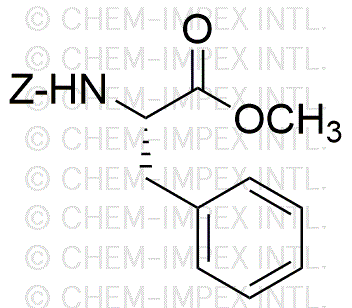Z-L-phenylalanine methyl ester is widely utilized in research focused on
- Peptide Synthesis: This compound serves as a key building block in the synthesis of peptides, particularly in the pharmaceutical industry, where it helps create biologically active compounds.
- Drug Development: It is used in the development of new drugs, especially those targeting neurological conditions, due to its ability to influence neurotransmitter activity.
- Biochemical Research: Researchers employ this chemical in studies related to enzyme activity and protein interactions, providing insights into metabolic pathways.
- Cosmetic Formulations: The compound is incorporated into skincare products for its potential benefits in skin health, acting as a moisturizing agent.
- Food Industry: It is also explored for flavor enhancement in food products, leveraging its amino acid properties to improve taste profiles.
General Information
Properties
Safety and Regulations
Applications
Z-L-phenylalanine methyl ester is widely utilized in research focused on
- Peptide Synthesis: This compound serves as a key building block in the synthesis of peptides, particularly in the pharmaceutical industry, where it helps create biologically active compounds.
- Drug Development: It is used in the development of new drugs, especially those targeting neurological conditions, due to its ability to influence neurotransmitter activity.
- Biochemical Research: Researchers employ this chemical in studies related to enzyme activity and protein interactions, providing insights into metabolic pathways.
- Cosmetic Formulations: The compound is incorporated into skincare products for its potential benefits in skin health, acting as a moisturizing agent.
- Food Industry: It is also explored for flavor enhancement in food products, leveraging its amino acid properties to improve taste profiles.
Documents
Safety Data Sheets (SDS)
The SDS provides comprehensive safety information on handling, storage, and disposal of the product.
Product Specification (PS)
The PS provides a comprehensive breakdown of the product’s properties, including chemical composition, physical state, purity, and storage requirements. It also details acceptable quality ranges and the product's intended applications.
Certificates of Analysis (COA)
Search for Certificates of Analysis (COA) by entering the products Lot Number. Lot and Batch Numbers can be found on a product’s label following the words ‘Lot’ or ‘Batch’.
Numéro de catalogue
Numéro de lot/série
Certificates Of Origin (COO)
This COO confirms the country where the product was manufactured, and also details the materials and components used in it and whether it is derived from natural, synthetic, or other specific sources. This certificate may be required for customs, trade, and regulatory compliance.
Numéro de catalogue
Numéro de lot/série
Safety Data Sheets (SDS)
The SDS provides comprehensive safety information on handling, storage, and disposal of the product.
DownloadProduct Specification (PS)
The PS provides a comprehensive breakdown of the product’s properties, including chemical composition, physical state, purity, and storage requirements. It also details acceptable quality ranges and the product's intended applications.
DownloadCertificates of Analysis (COA)
Search for Certificates of Analysis (COA) by entering the products Lot Number. Lot and Batch Numbers can be found on a product’s label following the words ‘Lot’ or ‘Batch’.
Numéro de catalogue
Numéro de lot/série
Certificates Of Origin (COO)
This COO confirms the country where the product was manufactured, and also details the materials and components used in it and whether it is derived from natural, synthetic, or other specific sources. This certificate may be required for customs, trade, and regulatory compliance.


